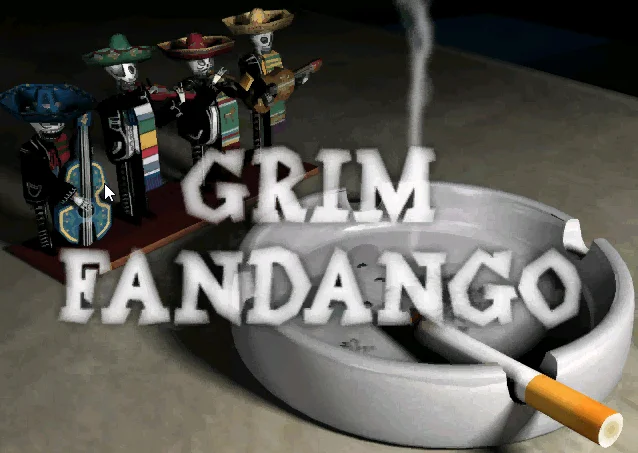Grim Fandango is a landmark title in gaming history, known for its unique blend of storytelling and art. This blog post delves into its origins, gameplay, and lasting influence on the gaming industry.
Table of Contents
The Origins of Grim Fandango
You know, Grim Fandango has this spot in my heart that’s just, well, irreplaceable. I first stumbled across it during my college years when I was on the prowl for anything LucasArts. Back in 1998, LucasArts had this magic touch for creating these otherworldly adventures, and Grim Fandango was no exception. It’s not easy to forget the moment I unwrapped that game box (remember those?) and found myself face-to-face with something so utterly unique. Tim Schafer was the mastermind behind it all—his reputation for crafting unforgettable narratives was already stellar due to games like Day of the Tentacle and Full Throttle, but this one felt different. It seemed like he and his team wanted to redefine what storytelling meant in a game, and boy, did they deliver.
The game’s premise revolves around Manny Calavera, a travel agent in the Land of the Dead, helping souls reach their final resting places. Picture it: you’re navigating the intriguing afterlife, finessed in film noir aesthetics with a healthy infusion of Mexican folklore. The storyline is a heady mix of humor, mystery, and emotional depth, and let me tell you, immersing myself in that world was like diving headfirst into a storybook where every page turn was a delightful surprise—and sometimes a facepalm moment when I got myself stuck on a puzzle.
Unique Art and Storytelling Styles
The visual style is one of those elements that once you see it, it stays etched in your mind forever. It’s like if Casablanca met Día de los Muertos and decided to have a whimsical jamboree. The film noir influence is heavy, with shadowy corner lighting and sharp silhouettes setting the tone. But what really mesmerized me was how the Mexican folklore added layers of cultural vibrance and authenticity. Those calaca-inspired character designs were more than just visually striking—they animated the narrative in ways that made it feel alive.
Now, talking about the narrative techniques, the dialogue and character development were the real MVPs. Engaging in rich, witty exchanges with quirky characters like Glottis the demon mechanic wasn’t just entertaining; it was humanizing. Moments of genuine connection with digital personas taught me more about empathy and problem-solving than some real-life conversations ever did—no joke! Crafting dialogues where each line reveals a smidge more of a character’s inner world is something Grim Fandango nailed, making it a bona fide storytelling benchmark.
Gameplay Mechanics
I remember being totally floored by the puzzles in Grim Fandango. The complexity was on another level, which was both a blessing and a curse. Sometimes I’d be up late, too stubborn to search for guides, wracking my brains to fit the pieces together in this maddening yet marvelous puzzle design. This challenge-response loop made every eureka moment that much sweeter and kept me thoroughly invested in Manny’s journey, despite moments where I was nearly ready to pull my hair out (not literally, but you know what I mean).
The exploration mechanics were intriguing, too—navigating the world was like waltzing through a virtual art exhibit where every interaction felt meaningful. There were instances where I got frustrated with the quirky movement controls, but ultimately, it all added another layer to this endearing clunkiness, mirroring life’s own unpredictability.
Legacy and Impact on Gaming
Grim Fandango may have launched to modest commercial success, but critically, it was acclaimed like nobody’s business. The narrative depth, the innovative integration of art and voice acting, all these elements made it shine at award shows and beyond. It taught me that sometimes the most valuable things aren’t those that sell like hotcakes immediately but those that gradually enrich our understanding of the medium’s limits.
Its influence on modern adventure games can’t be overstated. The foundations it laid are still visible in how many narrative-driven games approach storytelling today. Titles like The Wolf Among Us and Oxenfree owe much to the trail Manny’s tale blazed through the game development landscape.
The Remastered Edition
When the remastered version dropped in 2015, it was like new life breathed into an old friend. Enhancements included improved graphics and controls, making the experience smoother, while preserving the cherished nostalgia. It was unreal revisiting Rubacava with updated visuals that reconciled my childhood memories with my adult expectations—absolute magic!
Seeing the fan reactions was another trip. There was this collective buzz of excitement—a community that had kept the flame alive finally getting the chance to relive the magic, brand new coat of paint and all. Comparing then and now, it was clear the remastered edition succeeded in amplifying the heart of what made Grim Fandango profound to us.
Why Grim Fandango is Still Relevant Today
Themes of morality, redemption, and our relentless quest for meaning are perpetual. Manny’s journey is infused with these timeless narratives that remain as resonant today as they did in 1998. Rediscovering these stories has helped me navigate through some pretty trying times—a comforting reminder of shared struggles and universal human experiences.
The Grim Fandango fandom is alive and kicking. Whether it’s cosplay at conventions or passionate testimonials online, this community is proof that great stories are immortal. They’re not just retro gamers or nostalgia chasers; they’re part of an enduring legacy that keeps our beloved Land of the Dead vivid and very much relevant.
Conclusion
Grim Fandango’s legacy endures, captivating new and old players alike. Experience or revisit this classic to understand its profound impact on gaming.


